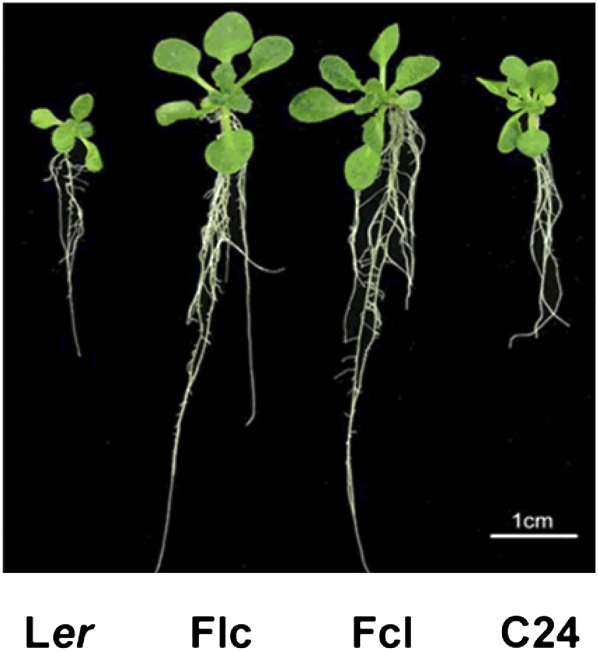Heterosis refers to the increased vigor of crosses between species (or between distantly related variants within a species) compared with the parents. Although heterosis, or hybrid vigor, has been recognized for well over a century, its molecular basis has remained a matter of debate and is surprisingly poorly understood (Birchler et al., 2010). Recent progress has pointed to a role for epigenetics in heterosis (Groszmann et al., 2011). In a new Large-Scale Biology Article, Shen et al. (pages 875–892) provide valuable information about the underpinnings of heterosis by comparing global DNA methylation, small RNA (sRNA) expression, and gene expression patterns in hybrids and their parents.
Shen et al. established reciprocal crosses between Arabidopsis thaliana C24 and Landsberg erecta ecotypes. The resulting F1 hybrids exhibited heterosis, with increased growth and more siliques than either parent (see figure). The authors then used methylC-seq to sequence the entire cytosine methylome of both parents and the reciprocal hybrids, finding that both hybrids had increased cytosine methylation compared with the parents. In addition, the growth of both hybrids was more sensitive to a chemical inhibitor of methylation than was that of the parents, supporting a role for DNA methylation in growth vigor.
Heterosis of reciprocal hybrids between Landsberg erecta (Ler) and C24 ecotypes. Fifteen-day-old Arabidopsis F1 hybrids and their parents. Flc, maternal line is Ler; Fcl, maternal line is C24. (Reprinted from Shen et al. [2012], Figure 1.)
Groszmann et al. (2011) recently reported that changes in short interfering RNA and DNA methylation levels appear to be related to heterosis, and sRNAs are known to be involved in establishing DNA methylation through RNA-directed DNA methylation (Law and Jacobsen, 2010). Shen et al. used high-throughput sequencing to examine the global sRNA expression profiles of the parents and the hybrids. They found that regions of the genome that give rise to sRNAs had increased DNA methylation in all lines, and the hybrids had even higher levels of methylation in those regions. Overall, their data support a model in which regions that give rise to sRNAs and show differential methylation between the parents account for the increased methylation in the hybrids. In this model, sRNAs covering a highly methylated area in either parent would act in trans to direct methylation in the hybrid.
Shen et al. also examined the transcriptomes of the parents and hybrids, finding that more genes were downregulated in the hybrids than were upregulated. Integration of the DNA methylome, the sRNAome, and the transcriptome data supports the idea that increased methylation of the circadian clock genes CIRCADIAN CLOCK ASSOCIATED1 and LATE ELONGATED HYPOCOTYL, which have been reported to be involved in heterosis, leads to their downregulated expression in the hybrids. In addition, the authors found DNA methylation and repression of flavonoid biosynthesis genes, with concomitantly increased auxin transport and signaling activity in the hybrids.
Mutant analysis further supported the notion that sRNAs are active in heterosis, perhaps by guiding methylation of DNA via the RNA-directed DNA methylation pathway, and that the circadian clock and flavonoids play roles in generating the heterotic phenotypes. Thus, these data from Shen et al. provide useful insights for future research into heterosis.
References
- Birchler J.A., Yao H., Chudalayandi S., Vaiman D., Veitia R.A. (2010). Heterosis. Plant Cell 22: 2105–2112 [DOI] [PMC free article] [PubMed] [Google Scholar]
- Groszmann M., Greaves I.K., Albertyn Z.I., Scofield G.N., Peacock W.J., Dennis E.S. (2011). Changes in 24-nt siRNA levels in Arabidopsis hybrids suggest an epigenetic contribution to hybrid vigor. Proc. Natl. Acad. Sci. USA 108: 2617–2622 [DOI] [PMC free article] [PubMed] [Google Scholar]
- Law J.A., Jacobsen S.E. (2010). Establishing, maintaining and modifying DNA methylation patterns in plants and animals. Nat. Rev. Genet. 11: 204–220 [DOI] [PMC free article] [PubMed] [Google Scholar]
- Shen H., He H., Li J., Chen W., Wang X., Guo L., Peng Z., He G., Zhong S., Qi Y., Terzaghi W., Deng X.W. (2012). Genome-wide analysis of DNA methylation and gene expression changes in two Arabidopsis ecotypes and their reciprocal hybrids. Plant Cell 24: 875–892 [DOI] [PMC free article] [PubMed] [Google Scholar]



